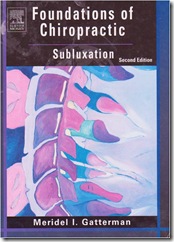For over one hundred years chiropractors have fought to protect their unique identity. In 1987, Judge Getzendanner concluded that the American College of Surgeons and the American College of Radiology had participated in a conspiracy with the medical association to make it difficult for chiropractors to work in the US.
This should have been a watershed moment for the chiropractic profession as I was planning to begin studying chiropractic. The enemy is no longer those in the medical profession but those among the ranks who want to force all chiropractors to take the biomedical path they are on. The chiropractic profession stands on the shoulders of giants who based their practice on the relationship between the structure of the spine and the function of the nervous system, to achieve wellbeing, without the use of “drugs or surgery”.
in 1910 chiropractors came up with a term to describe the “spinal joint dysfunction” they were adjusting. A “Vertebral Subluxation” was the name given to the spinal lesion being palpated that needed “correcting”. Another play on medical terminology was used to describe what was being affected by the adjustment; “dis – ease”, this may have sounded very clever in 1920, but became a stick for critics to beat chiropractors with in later year, by deliberately removing the hyphen stating chiropractors claimed to cure all “disease”. Worse still chiropractors, not able to get into medical school, began doing the same as they sought to make chiropractic a branch of “manual medicine”.

In the 90s Meredil Gatterman wrote what I believe, is the most authoritative book on chiropractic theory for the 21st century. She sets out the tone early on by stating “When it comes to communicating the language of “vertebral subluxation theory” chiropractors struggle Adopting the approach of Humpty Dumpty in Lewis Carrols Through the Looking Glass “…..when I use a word, Humpty Dumpty said in a rather scornful tone, “it means what I chose it to mean- neither more or less….”
Subluxation is a medical term for joint hyper mobility a contraindication for an adjustment as is joint fusion at the other end of a joint’s range of motion. There are recognised grades of joint dysfunction across the board so for the purpose of chiropractic terminology “subluxation” is a good word. However “dis – ease” is not. This is what I came up with slightly adapted from Gattermans definition, that I believed the vast majority of chiropractors would accept, when I was a member of the GCC.

” A theoretical model of vertebral motion segment dysfunction, that incorporates the complex interactions (homeostasis / innate), of pathologic changes in nerve, muscle, ligamentous vascular and connective tissues that affects adaptability to physical, chemical and emotional stresses and compromises general wellbeing”
Ultimately, debates about whether the subluxation complex is associated with pain and debates about the existence of the subluxation complex illustrate that our profession has not adequately applied the principles of pathology and neuroscience to the spine.
Pain is a symptom that is considered a component of subluxation syndromes, but it need not be present for the subluxation complex to exist. Similarly, heart disease, cancer, diabetes, alzheimer’s disease, cirrhosis, osteoporosis, and all other chronic diseases are known to exist long before symptoms appear. Why should this be any different for the subluxation complex?
Research has clearly demonstrated that pathologic changes of the spinal column, which we call the subluxation complex, may exist without symptoms. Consider that significant disc herniations can be present in individuals without back pain and that atrophic changes and fatty infiltration of spinal muscles exist in 45% of asymptomatic individuals.
and biomechanically stressed tissues will release chemical mediators of inflammation that constitute the biochemical changes of the subluxation complex. It is known that the cells of injured discs and joint tissue release chemical mediators, such as proinflammatory eicosanoids (prostaglandin-E2, leukotriene-B4, thromboxane-A2) and proinflammatory cytokines such as interleukin-1 and tumour necrosis factor.
These biochemical changes that we associate with the subluxation complex can stimulate spinal nociceptors and generate the back pain we commonly encounter. Initially, such biochemical changes can occur without obvious signs of degeneration, inflammation, and nociception and without the generation of symptoms – the way that every chronic disease begins.

Considering the fact that nociceptive input reaches subcortical areas, such as the brainstem and hypothalamus, it is also likely that a wide variety of neuroendocrine responses and seemingly unrelated symptoms could develop in response to a sensitised nociceptive system (or a system with decreased mechanoreception to inhibit nociception). In other words, pain may not be the symptomatic outcome of nociceptive stimulation of spinal structures.
Chiropractic is based on the scientifically proven hypothesis that proper structure of the spine is required for proper function of the nervous system as it relates to the control and regulation of global physiology and health. Traditional Chiropractic has never been and should never be defined as manipulation to reduce symptoms of back pain.
